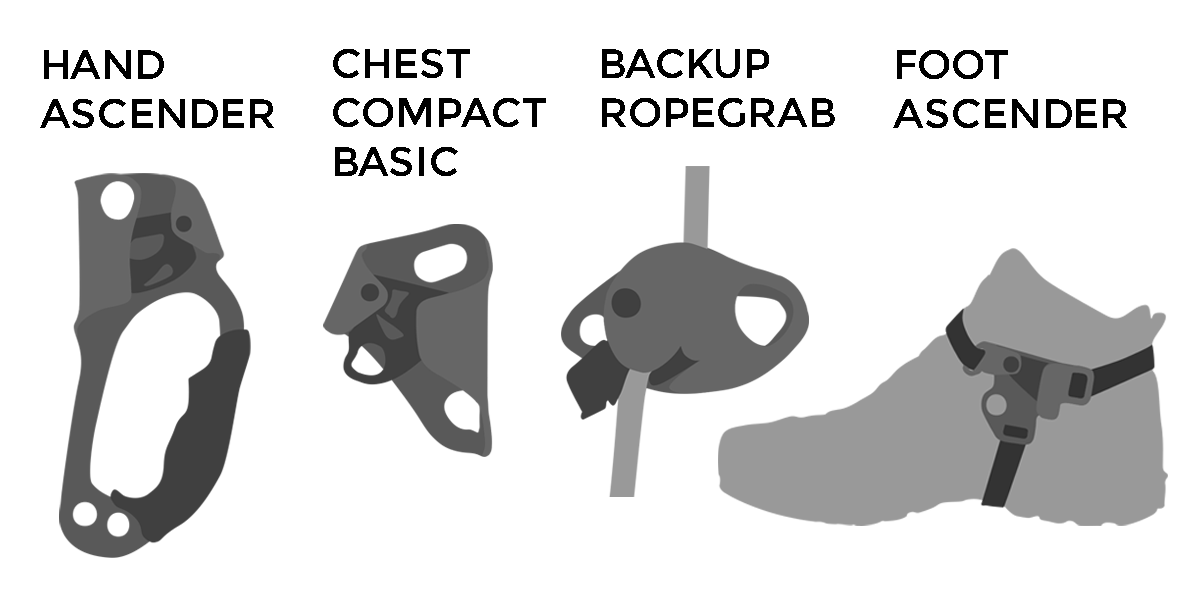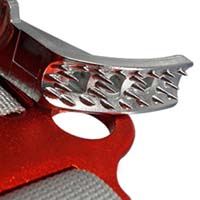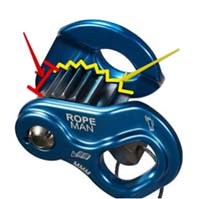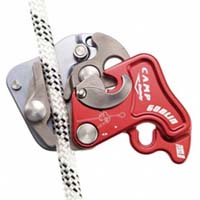Collecting every piece of gear takes a little time.
We think it's worth the wait.
Nice choice!
Give us a moment to collect those options for you.



Hand ascenders are used to manually ascend rope by pulling down with hands. They always have handles and are typically made in left and right hand versions.
Chest, Compact and Basic ascenders are often used in conjunction with other rigging or devices for ascending rope or progress capture. Their shape is made to be pulled down on and they have lower holes for attachment, though they aren’t as comfortable to use as hand ascenders. The upper holes also allow them to be used as a trailing backup.
Backup or Rope Grab ascenders are used as emergency backups and efficiency devices in hauling situations. They are usually trailed behind a climber via a sling when ascending a fixed line, or to give mechanical hold on a rope when pulling on a weighted line.
Foot ascenders allow direct attachment of the foot to a rope and are most often used in arboriculture and work at height situations where the only thing to climb is a rope. They typically do not have holes for attachment of carabiners and do not function as safety backups.


The teeth on toothed ascenders are usually conical and sharp. They are designed to physically bite into the sheath of the rope. Toothed ascenders are the most common for devices made to climb rope.

Ridged tooth ascenders clamp on the rope with flat, jagged teeth that are the width of the device. The teeth do not bite into the rope sheath but rather clamp it with the force of the triangular shape of the teeth. Ridged teeth are usually seen on backup ascenders but do also appear on foot, chest and pulley capture devices.

Very few toothless ascenders exist but some manufacturers tout toothless as a benefit of reducing wear on ropes. This style is mostly found on rope clamp/hauling devices.



Manufacturers provide holes for attaching carabiners and equipment to the bottom of ascenders. Some of these are made to accept one or more carabiners, while others are designed to accept one carabiner and a quick link (or maillon) for semi-permanently attaching a loop or ladder. Usually only ascenders made to operate attached to or above a climber have lower attachment holes. This option only applies to devices with both Upper and Lower holes.


Hand ascenders are made with handles designed to be held and operated by the left or the right hand, however there are a few that have 2 handles designed to be used by both hands.
Foot Ascenders are usually made to attach to a specific foot, left or right, or may be either/or.
Most other types tend to not have a preference for handling or are not made to be pulled on without additional carabiners, ladders or materials and are considered both left and right handed.


Some rope grab devices function as a weight certified pulley when hung from an anchor in a hauling situation. These pulleys ease efficiency and movement of the rope when under load but in order to be safely used to haul large weights and humans, these devices must pass extra certification (EN 12278/UIAA). Note: Not all devices with rolling surfaces/pulleys have been certified to be used as a pulley. Certified Pulleys should not be confused with Built-in Rollers which are not rated to hold weight.
These ascenders have a built in single slot for passing the rope through which allows the ascender to be used as a belay device in a controlled descent on a single rope. While designed to allow a climber to transition from ascending to descending on the same rope, this feature can also be used to lower out a climber or load and could technically be used to belay in a pinch.
A built-in roller can be helpful when working at height or ascending a rope with a progress capture device. It can help to add efficiency and give mechanical advantage by redirecting the rope above the climber. This can also be helpful during hauling situations where continual dropping and lifting of a climber’s weight is necessary. These rollers are not rated as a piece of PPE and should not be confused with Certified Pulleys which are tested to hold a climber’s weight or heavier loads.
A middle hole that a carabiner can fit through. This is particularly helpful for higher placement of a carabiner pulley setup.
Some ridged toothed ascenders are designed to be used on flat webbing as well as ropes. Their intent is not necessarily for vertically scaling webbing, but rather for clamping backups and positioning along webbing, which can be particularly useful during rescue and work at height situations.


If you'd like to narrow down your search by what others consider to be, "The Best Gear" this is your filter. We’re including all the media awards from the magazines like Climbing, Rock and Ice, and Alpinist, along with online resources like Gear Junkie, Outdoor Gear Labs, and more.
We scour the internet for new awards quarterly. If you know of some reputable awards that we’re missing, send us a note so we can check them out.
We do our very best to find and display every technical spec for every piece of climbing gear in the world. But sometimes we just can’t dig up a spec or two (usually it's the official price and weight). Sadly, this means not every product is available for filtering and sorting :(
If we allowed products that are missing key specs to display in the results above, these incomplete products would need to appear no matter what filters you chose. This would make the filtered results cluttered and misleading. So instead of leaving out these incomplete products entirely, we're listing them below: